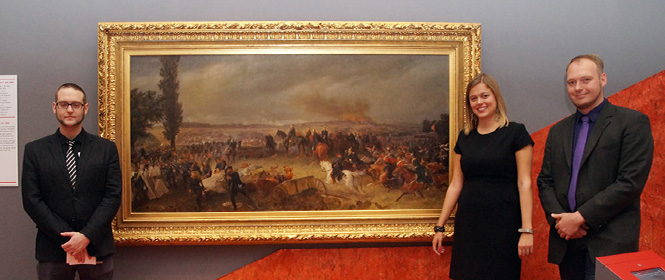
LAUREL WREATHS FOR THE KING
Our assistant curator Charlotte Röttger tells us about her first exhibition: the Focus Königgrätz special presentation within the permanent exhibition of Deutsches Historisches Museum.
Our research assistant curators working with the collections of Deutsches Historisches Museum, Charlotte Röttger, Christopher Jütte and Marcel Kellner, are relieved: the Focus Königgrätz special presentation on the upper floor of the permanent exhibition is ready on time. Working together as a team, the three young assistant curators developed and implemented their first exhibition – a huge responsibility. 3 July is the 150th anniversary of the Battle of Königgrätz, which saw the Prussian military face the armies of Austria and Saxony. Nowadays, hardly anyone is still aware that this battle decided Germany’s future. Prussia’s victory established Prussian hegemony in the German states and paved the way for the founding of the German Reich under Kaiser Wilhelm I.
INTENSIVE RESEARCH, UNIQUE HISTORICAL EVIDENCE
Following roughly one-and-a-half years of research training, Röttger, Kellner and Jütte have gained an excellent insight into the collection of Deutsches Historisches Museum. In just four months, they managed to select the exhibits for the presentation, some of which had previously never been displayed.
‘It wasn’t easy for us to select individual exhibits representative of the event from the vast array of objects to choose from. After all, the collections of Deutsches Historisches Museum encompass almost one million pieces. For us, it was important to not only chart the course of the battle, but also the reactions of the population. With this in mind, we found a letter sent by field post and a diary,’ explains Art History graduate Charlotte Röttger, describing her research work in the collection depots.
It was clear to her that Georg Bleibtreu’s impressive painting, Battle of Königgrätz on 3 July 1866, which is one of the most famous works connected with the event, should be at the heart of the exhibition. In addition, the young researchers are particularly proud of two further pieces: laurel wreaths in gold and silver.
PUBLIC VICTORY CELEBRATIONS AND GIFTS FOR THE KING
People’s representatives donated the laurel wreaths to show their gratitude to the king. Although it cannot be conclusively proven that the golden laurel wreath was handed over, the time and circumstances of the handover of the silver laurel wreath are documented in detail. Berlin, 21 September 1866: on the second day of the public victory celebrations for the Battle of Königgrätz, groups representing tradesmen such as masons and carpenters started lining both sides of Unter den Linden to hail Wilhelm I.
Accompanied by his retinue, the Kaiser rode on his battle steed beneath the lime trees and through the Brandenburg Gate, cheered on by the spectators. When he reached the fisherman’s guild, he stopped and, as later reported in the newspapers, ‘was greeted by three maidens dressed in white, the daughters of master fishermen. Miss Johanna Bild addressed a few kind words to the king, whilst Miss Bertha Bruckhoff handed him a solid silver laurel wreath and Miss Pauline Bild handed the crown prince a green laurel wreath.’*
He then proceeded to ride to the royal palace. Assistant curator Charlotte Röttger: ‘As we can hardly imagine anything similar in this day and age, we decided to include these two wreaths as contemporary evidence. They also symbolise the Prussian hegemony won at Königgrätz and the ensuing establishment of the German Reich under Prussian leadership.’
Anyone who wishes to see the wreaths for themselves has until 31 December 2016 to do so. At the end of the special presentation, they will be returned to Hohenzollern Castle in Baden-Württemberg on permanent loan from Deutsches Historisches Museum. Following their two-year traineeship, Charlotte Röttger, Christopher Jütte and Marcel Kellner are aiming to do a doctorate, which – just like a research training – is more or less an essential requirement for anyone who wishes to land one of the coveted research posts available in museums.
* Neue Münchener Rundschau: (mouthpiece of the ‘Verein zur Hebung des Credits’). 17 October 1866, page 18